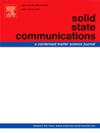Sm3+掺杂LaAlO3纳米荧光粉的制备及性能研究
IF 2.1
4区 物理与天体物理
Q3 PHYSICS, CONDENSED MATTER
引用次数: 0
摘要
利用溶液燃烧合成法,制造出了 LaAlO3:Sm3+ (1-9 mol %) 纳米粒子 (NPs)。结构研究采用了多种分析方法,包括 PXRD、FTIR、SEM 和 TEM。研究发现,其带隙在 4.9 至 5.3 eV 之间。通过分析光致发光光谱,研究了合成 NPs 的光学特性。在 850 ℃ 下,煅烧产生了纯斜方体相。纳米粒子的 SEM 照片显示了团聚的多孔结构。在 406 nm 的激发波长下,PL 光谱显示 Sm3+ 离子在 4G5/2 转变的 6HJ = 9/2、7/2 和 5/2 有明显的发射峰,呈黄橙色,并得到 CIE 坐标的证实。此外,还利用 LaAlO3 进行了亚甲基蓝染料的光催化降解:Sm3+ (5 mol %) 纳米粒子进行光催化降解亚甲基蓝染料。在紫外光下,180 分钟的短时间内,亚甲基蓝染料的降解率为 99%,在日光下为 91%。值得注意的是,在多种阳离子存在的情况下,染料降解仍然有效(高达 85%)。再生和可重复使用性研究进一步证实了该材料强大的光催化活性。这些材料有望用于生产光致发光液晶显示器、场发射显示器和其他光学设备,这些纳米粒子还可用作污染物水处理的高效光催化剂。本文章由计算机程序翻译,如有差异,请以英文原文为准。
Facile fabrication and characterization of Sm3+ doped LaAlO3 nanophosphors for enhanced luminescence and photocatalytic dye degradation
Utilizing the solution combustion synthesis approach, LaAlO3: Sm3+ (1–9 mol %) nanoparticles (NPs) were created. Several analytical methods, including PXRD, FTIR, SEM, and TEM, are used to do the structural study. It is discovered that the band gap lies between 4.9 and 5.3 eV. The optical properties of the synthesized NPs are investigated by analyzing photoluminescence spectra. At 850 °C, calcination yields a pure rhombohedral phase. SEM pictures of the nanoparticles show the agglomerated porous structure. The PL spectra show Sm3+ ions' distinctive emission peaks to 6HJ = 9/2, 7/2, and 5/2 from 4G5/2 transitions with a yellowish orange shade under the excitation wavelength of 406 nm and confirmed by the CIE coordinates. Additionally, photocatalytic dye degradation of methylene blue dye is carried out using LaAlO3: Sm3+ (5 mol %) nanoparticles. In 180 min of short duration, under UV light, the % degradation of methylene blue dye is 99 %, and under sunlight 91 %. Notably, the dye degradation remained efficient (up to 85 %) in the presence of multiple cations. Regenerative and reusability studies further confirmed the material's robust photocatalytic activity. These materials are promising candidates for the production of photoluminescence liquid crystal displays, field emission displays, and other optical devices, along with these nanoparticles can be used as an efficient photocatalyst for pollutant water treatment.
求助全文
通过发布文献求助,成功后即可免费获取论文全文。
去求助
来源期刊

Solid State Communications
物理-物理:凝聚态物理
CiteScore
3.40
自引率
4.80%
发文量
287
审稿时长
51 days
期刊介绍:
Solid State Communications is an international medium for the publication of short communications and original research articles on significant developments in condensed matter science, giving scientists immediate access to important, recently completed work. The journal publishes original experimental and theoretical research on the physical and chemical properties of solids and other condensed systems and also on their preparation. The submission of manuscripts reporting research on the basic physics of materials science and devices, as well as of state-of-the-art microstructures and nanostructures, is encouraged.
A coherent quantitative treatment emphasizing new physics is expected rather than a simple accumulation of experimental data. Consistent with these aims, the short communications should be kept concise and short, usually not longer than six printed pages. The number of figures and tables should also be kept to a minimum. Solid State Communications now also welcomes original research articles without length restrictions.
The Fast-Track section of Solid State Communications is the venue for very rapid publication of short communications on significant developments in condensed matter science. The goal is to offer the broad condensed matter community quick and immediate access to publish recently completed papers in research areas that are rapidly evolving and in which there are developments with great potential impact.
 求助内容:
求助内容: 应助结果提醒方式:
应助结果提醒方式:


